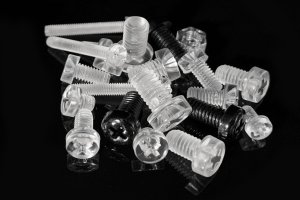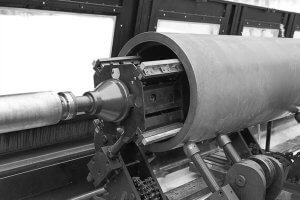Why CNC Machine Silicone Sheets?
Cutting soft materials like silicone sheets used to feel like guesswork. I remember the first time I tried running a CNC job with a soft silicone pad—it bunched up, melted slightly, and left ragged edges that were totally unusable. It taught me something early: silicone sheets behave nothing like plastic or wood.
And that’s the point of this guide.
This article is for anyone who wants to learn how to CNC cut silicone sheets without dealing with torn edges, warped cuts, or misaligned holes. Whether you’re making gaskets, thermal pads, or custom medical components, CNC Machining offers huge benefits—if you use the right tools, settings, and workflows.
We’ll walk through:
- What silicone sheets are and why they’re useful
- Which CNC machines can handle them
- What tools and parameters work best
- How to hold them in place without distortion
- What real-world projects look like
- How to fix common problems like tearing and melting
If you’re tired of ruining expensive silicone sheets or want to move from manual trimming to digital precision, this is your step-by-step reference.
Understanding Silicone Sheets
Silicone sheets are flexible, durable, and highly resistant to heat and chemicals. They’re used in industries ranging from electronics to healthcare. But they’re not all the same.
Here’s a breakdown of the most common types of silicone sheets I’ve encountered in production work:
| Type | Typical Use | Shore Hardness | Thickness Range | CNC Friendly? |
|---|---|---|---|---|
| Industrial Silicone | Gaskets, seals | A40–A80 | 0.5–10 mm | ✅ Yes |
| Food-Grade Silicone | Baking liners, conveyor pads | A20–A60 | 1–5 mm | ✅ Yes |
| Medical Silicone | Skin-contact devices, wound care | A10–A40 | 0.3–3 mm | ⚠️ Delicate |
| Thermal Silicone | Heat-transfer pads | A20–A70 | 0.5–2 mm | ✅ Yes |
| Foam Silicone | Cushioning, insulation | A5–A30 | 3–20 mm | ❌ No (Too soft) |
| Reinforced Silicone | High-load applications | A50–A90 | 1–8 mm | ✅ Yes |
| Conductive Silicone | EMI shielding, electronics | A30–A70 | 0.5–2 mm | ✅ Yes |
I’ve found that Shore A 40–60 silicone sheets offer the best balance for CNC cutting. Too soft, and they squish under the tool. Too hard, and they behave more like rubber, which tends to bounce or tear.
Silicone sheets are commonly purchased in rolls or flat sheets. Some are pressure-sensitive (adhesive-backed), and others are meant to be bonded to other substrates. All these variations affect how you should approach CNC machining.
So before you even power on your machine, know this:
- Softer silicone sheets require gentler tooling
- Thickness affects both tool selection and fixturing
- Adhesive backing may gum up your bit if you’re not careful
Understanding the material properties is step one in making clean, accurate CNC cuts without damaging your silicone sheets.
CNC Machining Methods for Silicone Sheets
Not all CNC methods are equally suited for silicone sheets. Depending on the material’s thickness and softness, some approaches will deliver perfect edges, while others will stretch, scorch, or smear your part.
I’ve worked with at least four CNC methods on silicone sheets. Here’s how they compare:
🔧 Overview of CNC Cutting Methods
| Method | Strengths | Weaknesses | Best For |
|---|---|---|---|
| CNC Router | Available, precise, scalable | Can cause tearing/stretching | Harder silicone sheets (>A40) |
| Laser Cutter | Clean edges, no contact | Can burn, smoke, discolor | Thin silicone sheets (<2 mm) |
| Waterjet | No heat, clean for thick cuts | Expensive, messy, overkill for thin jobs | 3–10 mm thick silicone sheets |
| Oscillating Knife | Clean cuts, no heat | Limited to flat 2D cutting | Soft silicone <3 mm, foam types |
✅ My Recommendation
If you’re working with thin to medium silicone sheets (0.5–5 mm), a CNC router or an oscillating knife system is your best bet—provided you use the right tooling and fixturing.
For super-thin thermal pads or precision medical-grade silicone sheets, laser cutting works, but you’ll need to dial in low power settings and ensure proper exhaust to manage fumes. I’ve burned edges more than once by being careless here.
For high-volume, thick parts—like cushioning gaskets—a waterjet delivers the cleanest cuts without heat, but only if you’re already set up for it.
Tooling and Cutting Parameters
This is where I made the biggest leap in quality. When I stopped treating silicone sheets like soft plastic or foam and started dialing in material-specific feeds, tools, and cut depths, everything improved: cleaner edges, less waste, and better repeatability.
🧰 Best Tools for CNC Cutting Silicone Sheets
| Tool Type | Use Case | Pros | Cons |
|---|---|---|---|
| Oscillating knife | Thin soft silicone (<2 mm) | Super clean, no heat | Expensive heads, slow speed |
| Drag knife | Adhesive-backed sheets, prototyping | Simple setup | Less accurate, poor for thick cuts |
| Single-flute bit | Medium hardness silicone (A40–A60) | Good chip ejection | Can heat up fast, causes tearing |
| Compression bit | Multilayer or bonded silicone | Clean top & bottom edges | Pricey, needs perfect feed |
| Downcut bit | Avoid top-edge fray | Protects surface | Traps chips, increases heat |
In my shop, I use an oscillating toolhead for thin silicone up to 2mm, and a single-flute carbide bit for harder sheets or foam-backed materials. When the cut matters most—like in visible medical or consumer-facing parts—I always do a final clean-up pass with reduced depth.
📏 Cutting Parameters I Use Regularly
| Material Type | Bit Type | RPM | Feed Rate (mm/min) | Depth per Pass | Notes |
|---|---|---|---|---|---|
| A50 silicone, 2 mm | Oscillating knife | — | 600–800 | Full depth | Perfect edges, no melt |
| A60 silicone, 5 mm | Single flute bit | 9,000 | 1,000–1,200 | 1.5–2 mm | Two-pass cut recommended |
| Foam silicone, 10 mm | Drag knife | — | 300–500 | 2–3 mm | Needs backing board |
| Thermal pad, 1 mm | Laser (low power) | 20% PWR | 10 mm/s | — | Watch for edge darkening |
| Medical-grade silicone | Compression bit | 8,000 | 800 | 0.5–1 mm | Cut slowly, avoid distortion |
💡 Real Lessons I’ve Learned:
- Avoid re-cutting over same path: this generates heat and melts the silicone.
- Sharp tools only: dull tools drag and deform silicone sheets instantly.
- Test your hold-down: flexible material lifts if not fully secured.
Also, I’ve noticed that cutting with too much depth at once increases the chance of warping or curling, especially in laminated or dual-layer silicone sheets. When in doubt, go slower, use multiple passes, and clean your bit between runs.
Workholding and Fixturing Techniques
Securing silicone sheets during CNC machining is tricky. They’re soft, stretchy, and love to move when they shouldn’t. Early on, I underestimated this step. One misaligned cut due to sheet shifting cost me a full 18” x 24” sheet—and it wasn’t cheap.
So here’s what I learned about holding silicone sheets firmly in place.
🔧 Common Workholding Options
| Method | Best For | Pros | Cons |
|---|---|---|---|
| Vacuum Table | Flat silicone sheets (2mm–5mm) | Uniform hold, no damage | Weak with small parts or thick sheets |
| Adhesive Backing | Thin sheets or laser jobs | Excellent grip, no clamps needed | May leave residue on spoilboard |
| Double-Sided Tape | Soft and short jobs (<10 parts) | Easy to set up, very sticky | Hard to reposition, residue build-up |
| Silicone Pad + Weights | Prototyping or testing | Protects bottom, reduces bounce | Low hold strength, only good for light passes |
| Custom Fixture Jigs | Repeat production cuts | Great for volume work, repeatability | High setup time, not flexible |
In my workshop, I use a vacuum table with an MDF spoilboard for most flat jobs. For small-run prototypes, I rely on 3M VHB tape or masking tape + CA glue if precision matters.
What’s important is avoiding distortion. If the silicone sheet stretches even slightly, your CNC path won’t align with reality. That’s how tear-outs and uneven edges happen.
📌 Tips That Helped Me:
- Use pin guides if you’re cutting in multiple passes, so re-alignment is dead-on
- If the material is too soft to hold flat, consider sandwiching it between two layers of sacrificial film or mylar
- For very thin silicone, a sticky silicone pad (ironically) works well to hold the base sheet still
A trick I picked up from another shop: lay a silicone sheet on top of a very lightly tacky surface (like a mat sprayed with repositionable adhesive). This keeps the part stable but doesn’t stretch it like hard taping might.
Surface Quality and Finishing
Once you’ve cut your silicone sheets cleanly, you still need to make sure they look and function right. That’s especially true if you’re shipping parts to a customer, building medical components, or integrating pieces into consumer products.
Here’s how I finish my CNC-cut silicone sheets and avoid the usual post-processing headaches.
🧽 Edge Finishing Techniques
| Method | Use Case | Tools Needed | Pros |
|---|---|---|---|
| Deburring by hand | Rough edges or fibers | File, sandpaper (400–600 grit) | Fast and simple |
| Edge rolling | For soft-touch or wearable items | Heat gun + curved jig | Smooths hard corners |
| Water rinse | Removes dust/residue | Warm water + soft brush | Gentle and clean |
| Air blow-off | Before packaging or inspection | Compressed air | Dust-free finish |
| Adhesive cleanup | For taped jobs | Citrus cleaner or alcohol wipe | Removes glue, doesn’t harm silicone |
I don’t flame-polish silicone edges like I would with acrylic. It just doesn’t work the same way. Instead, I use light sanding or soft sponging if the edge was compressed or roughened.
If the part was laser-cut, I usually get discoloration on the edges—especially with clear or translucent silicone sheets. This can be lightly buffed or trimmed back if needed. Otherwise, just accept it as a tradeoff unless you’re in the medical-grade world.
🔍 Tolerance and Quality Control
Silicone isn’t rigid, so tolerances can be misleading. A 0.1mm variance on a plastic part is tight; on a silicone part, it’s expected.
What I do is:
- Use go/no-go gauges when tight fit is critical (like for gaskets)
- Test fit parts with mating components right after machining
- Measure cut width right after cooling, not during the job (silicone expands slightly under heat)
Typical Applications and Case Studies
CNC cutting of silicone sheets shows up in more industries than you might think. From thermal pads in electronics to complex gasket profiles in aerospace, precision matters—and CNC helps get you there.
I’ve worked on dozens of silicone-based projects, and here are a few real-world examples to help you see how others are applying this material.
🧪 A. Thermal Pads for Electronics
A small electronics company I worked with needed 0.5 mm thick thermal silicone pads to fit between circuit boards and aluminum heat sinks. We used CNC laser cutting on low power to avoid burning. Tight tolerances and heat resistance were critical.
Key details:
- Material: Gray thermal silicone (A60, 0.5 mm)
- CNC method: Laser cutter with air assist
- Result: ±0.1 mm fit tolerance, clean cutouts
🛠️ B. Industrial Seals and Gaskets
For a valve manufacturer, we made hundreds of gaskets using 3 mm industrial-grade silicone sheets. Some had bolt holes, others had custom edge profiles. They previously used die-cutting but wanted to switch to CNC for more flexibility in sizes.
Key details:
- Material: Red silicone sheet (A70, 3 mm)
- CNC method: Router with single-flute carbide bit
- Notes: Double-sided tape used for fixturing
🏥 C. Medical Device Prototyping
I helped a medical startup create test pieces for wearable skin-contact devices. We used translucent silicone sheets around 1 mm thick, CNC-cut into curved shapes with notches for electrodes.
Key details:
- Material: Medical-grade silicone (A30, 1 mm)
- CNC method: Oscillating knife
- Notes: Held in place with tacky underlayer
| Use Case | CNC Method Used | Thickness | Tolerance Needed | Notes |
|---|---|---|---|---|
| Electronics thermal pad | Laser | 0.5 mm | ±0.1 mm | No charring, great detail |
| Industrial gasket | Router (carbide bit) | 3 mm | ±0.2 mm | Repeatable, high output |
| Medical skin patch | Oscillating blade | 1 mm | ±0.1 mm | Soft material, clean edge needed |
| Prototype keypads | Waterjet | 5 mm | ±0.3 mm | No distortion, handled large sheets |
| High-temp insulation | Drag knife | 1.5 mm | ±0.5 mm | For low-cost, fast turnaround |
Common Problems and How to Fix Them
I’ve made nearly every mistake possible when cutting silicone sheets. The good news? You can avoid them if you know what to expect and how to fix it.
❌ Problem 1: Tearing at Entry or Exit
Why it happens:
- Feed rate too fast
- Dull tool
- Improper support underneath
Fix:
- Use sharp, dedicated silicone-cutting tools
- Add sacrificial layer under the sheet
- Reduce cut depth per pass
❌ Problem 2: Melting or Burning
Why it happens:
- Laser power too high
- Poor chip evacuation
- Tool stays in one spot too long
Fix:
- Lower RPM or power
- Increase feed rate
- Clean tool between passes
❌ Problem 3: Material Shifting During Cut
Why it happens:
- Poor fixturing
- Sheet not flat
- Not enough suction on vacuum table
Fix:
- Use adhesive backing or tacky mats
- Add weight or clamps (carefully)
- Use tabbing in CAM file
❌ Problem 4: Sticky Residue on Tools
Why it happens:
- Cutting adhesive-backed silicone
- Silicone buildup due to friction
Fix:
- Clean tools with alcohol or citrus degreaser
- Apply light spray of dry lube before job
- Reduce spindle speed
❌ Problem 5: Warped or Curled Edges
Why it happens:
- Heat buildup during cut
- Material too soft or too thin
- Tool pressure deforms surface
Fix:
- Use oscillating knife or multiple shallow passes
- Add a cooling pause between passes
- Pre-flatten sheet with light pressure
Material and Equipment Recommendations
After years of testing different silicone sheets and tool setups, I’ve narrowed down what works consistently for CNC applications. These recommendations come from hands-on experience and feedback from other fabricators in the field.
🧾 Trusted Silicone Sheet Suppliers
| Brand / Supplier | Type of Silicone Sheets Offered | CNC-Friendly? | Notes |
|---|---|---|---|
| Silicone Engineering | Industrial, food-grade, medical | ✅ Yes | Excellent hardness range options |
| Stockwell Elastomerics | Thermal, EMI, medical | ✅ Yes | Clean surface finish, perfect for gaskets |
| McMaster-Carr | Wide variety (standardized sizes) | ✅ Yes | Easy to source small batch sheets |
| Rogers Corporation | PORON® and silicone foam composites | ⚠️ Partial | Foam edges may deform during cutting |
| Polymax UK | Roll-based and sheet silicone materials | ✅ Yes | Good for bulk industrial applications |
My personal go-to for small runs is McMaster-Carr due to their selection, while Stockwell has the highest quality surface finish I’ve worked with—great for clean-edge cutting.
🧰 CNC Tools and Machine Suggestions
| Equipment Type | Recommended Brand / Feature | Use Case |
|---|---|---|
| CNC Router | ShopSabre, AXYZ, Biesse | General silicone jobs, flat sheets |
| Laser Cutter | Epilog, Trotec (with air assist) | Thin silicone sheets, low-power cuts |
| Oscillating Knife Tool | Zünd, Summa, iEcho | Precision 2D profiles, soft sheets |
| Bits for Silicone | Amana Tool, Whiteside | Single-flute, downcut, compression |
| Fixturing Mats | SilcoPad, smooth silicone mats | Prevent material shifting |
If you’re just starting, an entry-level router with vacuum hold-down and a sharp single-flute bit will do the job. For production volumes, upgrade to an oscillating head or dual-tool system.
FAQ
🧠 General Machining
- Can you CNC machine silicone sheets?
Yes, with the right tooling and fixturing methods. - Which CNC machines work best for silicone sheets?
Routers, oscillating knife cutters, and waterjets. - Can I laser cut silicone sheets?
Yes, but watch for smoke, odor, and edge discoloration. - What sheet thickness is easiest to CNC?
1–3 mm. Thin enough to cut easily, thick enough to stay flat. - Can I engrave patterns into silicone sheets?
Yes—use a ball nose bit or laser for shallow detail.
⚙️ Tools & Parameters
- Which tool should I use to cut silicone sheets?
Oscillating knife for soft sheets, single-flute bit for harder ones. - What RPM and feed rate should I start with?
~8,000–10,000 RPM and 800–1200 mm/min are safe starting points. - How deep should I cut per pass?
1–2 mm per pass max, depending on thickness. - Do I need coolant or air assist?
Air assist helps with chip clearing, coolant usually not required. - How do I prevent the tool from sticking?
Keep tools clean, and avoid adhesive-backed silicone if possible.
🧷 Fixturing & Finishing
- How do I hold silicone sheets in place?
Use vacuum tables, tacky mats, or low-residue adhesives. - What’s the best spoilboard for cutting silicone?
MDF or silicone mats work well for repeatable jobs. - Can I cut multiple layers at once?
Yes, if the stack is securely compressed and aligned. - How do I remove burrs from silicone edges?
Use light sanding or trimming with sharp blades. - Do I need to clean silicone sheets before cutting?
Yes, especially if they’re dusty or oily—use isopropyl alcohol.
🧪 Advanced Use Cases
- Can I use silicone sheets in medical prototyping?
Yes, medical-grade silicone is safe and machinable. - Are there CNC templates for silicone gaskets?
Many sites like GrabCAD or Fusion 360 libraries have gasket models. - What tolerance should I expect when cutting silicone?
±0.2 mm is realistic due to material flexibility. - Can I cut silicone sheets on a desktop CNC machine?
Yes, with slow speeds, sharp tools, and good fixturing. - Where can I buy high-quality silicone sheets for CNC use?
Suppliers like Stockwell, Silicone Engineering, or McMaster-Carr.
Recommended Authoritative References
- Silicone – Material Overview
An in-depth article detailing the chemical structure, properties, and diverse applications of silicone materials, including their use in sealants, adhesives, and medical devices.
Source: Wikipedia – Silicone - Additive Manufacturing of Silicone Structures: A Review and Prospective
A comprehensive review discussing the advancements in additive manufacturing techniques for silicone structures, highlighting the potential and challenges in fabricating complex silicone components.
Source: ScienceDirect – Additive Manufacturing of Silicone Structures - Gasket – Mechanical Seal
An informative piece explaining the function, types, and materials used in gaskets, emphasizing the role of silicone sheets in creating effective seals in various mechanical assemblies.
Source: Wikipedia – Gasket - 3D Printing – Liquid Additive Manufacturing
An article exploring the liquid additive manufacturing process, particularly focusing on the deposition of high-viscosity materials like liquid silicone rubber, and its applications in creating complex silicone parts.
Source: Wikipedia – 3D Printing - Printed Silicone Pneumatic Actuators for Soft Robotics
A study presenting the fabrication of silicone-based pneumatic actuators using rapid liquid printing, showcasing the integration of silicone materials in soft robotics applications.
Source: ScienceDirect – Printed Silicone Pneumatic Actuators
Other Articles You Might Enjoy
- How to Make Silicone Molds with CNC: A Complete Guide
Why Choose Silicone Molds and the Role of CNC Technology Creating high-quality silicone molds can be a game-changer in prototyping and small-batch production. Silicone molds offer an efficient way to…
- Carbon Fiber Sheets in CNC Machining: Applications, Techniques, and Cost Insights
Introduction When it comes to lightweight and high-strength materials, carbon fiber sheets are among the top choices for industries like aerospace, automotive, and electronics. Their unique properties, such as rigidity,…
- Hard Plastic Sheets Explained For Makers And Machinists: Which One Is Right for Your Project?
Chapter 1: Introduction I've worked in manufacturing and DIY fabrication for years, frequently handling all types of materials. Among these, hard plastic sheets consistently proved versatile and reliable for various…
- How to Cut, Drill, and Modify ABS Pipe Using CNC Machines
Introduction ABS pipe is everywhere—from plumbing systems to DIY projects, from prototypes to structural parts in lightweight assemblies. But recently, I’ve noticed a growing trend: people want to take their…
- How to Cut Acrylic Sheet Cleanly and Precisely for Professional Use
Introduction to Acrylic and Its Uses Acrylic, also known as PMMA (Polymethyl Methacrylate), is one of the most versatile materials used across various industries today. Known for its clarity, durability,…
- Avoid Melting and Delamination When Machining Plastic Laminate
Introduction Plastic laminate is a beautiful material when it’s done right—and a real nightmare when it isn’t. I’ve been working with CNC machines for years, and if there’s one thing…
- Aluminum Plate for CNC Projects: A Practical Buying and Application Guide
Introduction If you've ever worked on a CNC project—whether in a garage workshop or a full-scale production facility—chances are you've handled an aluminum plate. I remember the first time I used…
- Aluminum Square Tubing for CNC Projects: From Material Choice to Precision Cutting
Introduction When I first started getting into CNC machining, I experimented with a bunch of different materials — wood, steel, plastics. But over time, aluminum square tubing became my default choice. It's…





